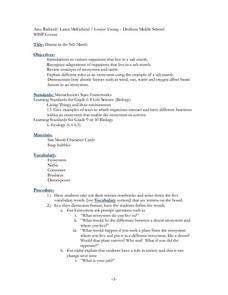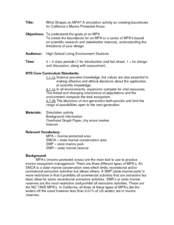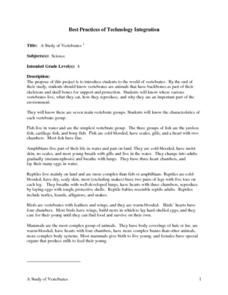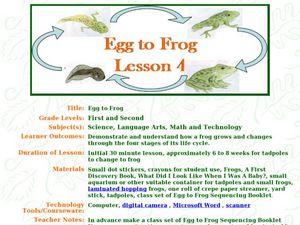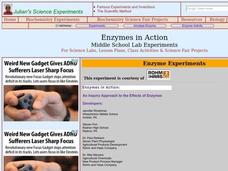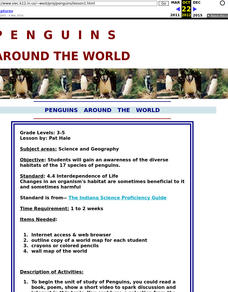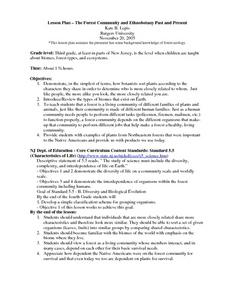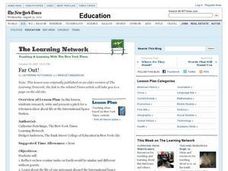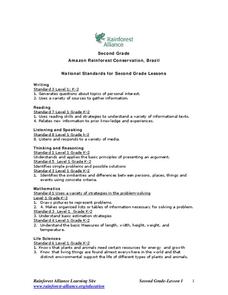Curated OER
Drama in the Salt Marsh
Students are introduced to the various organisms that live in a salt marsh. They recognize adaptations of organisms that live in the salt marsh. Pupils review concepts of the ecosystem and niche. Students explain the different roles...
Curated OER
Hunting Invertebrate Fossils in the Classroom
Students acquire a general knowledge of fossils and paleontology, the study of evidence of life in the past and identify the major invertebrate groups (phyla) commonly found in the fossil record.
Curated OER
Are Viruses Alive: Sample Socratic Questions
Students comprehend the definition and uniqueness of life and its complexities. They examine what characteristics constitute a living organism. Students recognize the extent of the role viruses play in the movement and molding of life as...
Curated OER
For the Birds
Second graders explore biology by creating birdhouses. In this bird identification lesson, 2nd graders discuss the different types of birds that live in their environment and what characteristics each type of bird has. Students create a...
Curated OER
What Shapes a MPA?
Learners identify the three types of MPA in California. For this marine science lesson, students analyze information provided to design a new MPA. They justify their reasoning in class.
Curated OER
Stream Study
Students study the characteristics of a stream habitat. In this life science lesson, students use sieves, nets, and jars to collect aquatic organisms. Students also measure the temperature of the stream and calculate the speed of the...
Curated OER
Lesson 12: Ho'olaulima: Let's Make a Hawaiian Garden
Second graders grow a classroom garden that acts as a living laboratory for cross-curricular activities. In this classroom garden lesson, 2nd graders follow directions to build and plant a garden that is used to teach math, science, and...
Curated OER
A Study of Vertebrates
Fourth graders investigate the characteristics of each vertebrate group. They take notes in a science journal, and in small groups create a HyperStudio slideshow presentation to present information about a specific vertebrate group.
Curated OER
"Lions and Tigers and Bears-Oh MY!"
Students explore the characteristics of an animal. What do all animals need to live and can what we expect to accomplish by studying about animals. They keep a science journal daily.
Curated OER
Egg to Frog
Students study the life cycle of the frog. For this life cycle lesson set, students listen to a read aloud of Frogs, A First Discovery Book, and make a sequencing booklet that shows the four stages of the frogs life cycle. They observe...
Curated OER
Enzymes in Action
Young scholars explore how enzymes are important in the chemical reactions of all living things. In this enzymes and catalysts lesson plan students complete an activity to see how enzymes change living things.
Curated OER
Wetland Food Webs
Middle schoolers study life science. In this food webs and food chains comparison lesson plan, students examine the wetlands to discover the relationships that exist between the animals that live there. They participate in group...
Curated OER
Amazing Desert Dwellers
Students explore the many adaptations desert animals have made to survive in their challenging habitat. They use this information to invent new creatures well-suited for desert life.
Curated OER
Penguins Around the World
Students gain an awareness of the diverse habitats of the 17 species of penguins. Standard: 4.4 Interdependence of Life Changes in an organism's habitat are sometimes beneficial to it and sometimes harmful.
Curated OER
In The Zone
Third graders identify ways that ocean animals grow, survive, reproduce, and adapt. They use computer Internet skills to acces and collect information. They create a PowerPoint presentation. They demonstrate writing skills throughthe...
Curated OER
The Forest Community And Ethnobotany Past And Present
Students describe a forest as a living community. They determine members interact, and in many cases, depend on each other for their basic survival needs. They investigate how dependent the Native Americans were on the forest...
Curated OER
Far Out!
Students research and compare/contrast how routine tasks on Earth would be without gravity. They read and discuss the article "The Life Galactic: A Lot of Work, a Little Play, Plenty of E-Mail." In groups they write a pitch for a TV...
Curated OER
Where Are the Dinosaurs?
Learners investigate dinosaurs. For this life science lesson, students watch video clips on the website http://dsc.discovery.com/convergence/dinos/video/video.html and discuss the characteristics of the dinosaurs. Learners create...
Curated OER
Amazon Rainforest Conservation, Brazil
Students explore rain forests. In this rain forest lesson, students participate in a "BioBlitz" of their schoolyard, observing and recording every living thing in a designated area. Students visit websites about rain forests...
Curated OER
Fable of the Fainting Goat
Second graders explore animal life by reading children stories in class. In this goat fable lesson, 2nd graders read several books which describe the different myths and folklore about goats. Students identify the needs of living animals...
Curated OER
My Little Seed House
Second graders explore plant life by participating in a germination activity. In this botany lesson, 2nd graders read several books about seed germination including Sunflower House and Tiny Seed. Students identify the necessary elements...
Curated OER
Change or Adaptation
Students identify the adaptive forces in the life cycle of plants, animals, and humans, isolate and identify the role that change and adaptation play in extreme environments and research and write a short term paper using MLA citations.
Curated OER
Forest Food Webs
Students consider the interdependency of life in a temperate forest by studying selected organisms from an Asian temperate forest and creating a food web.
Curated OER
How about a Little Give and Take?
Students design a closed system to test the relationships between plants and animals. They monitor abiotic fluctuations within this living system by using a chemical test kit. They observe how living organisms respond to fluctuations in...
